engine SKODA OCTAVIA 2010 2.G / (1Z) Repair Manual
[x] Cancel search | Manufacturer: SKODA, Model Year: 2010, Model line: OCTAVIA, Model: SKODA OCTAVIA 2010 2.G / (1Z)Pages: 275, PDF Size: 16.43 MB
Page 196 of 275
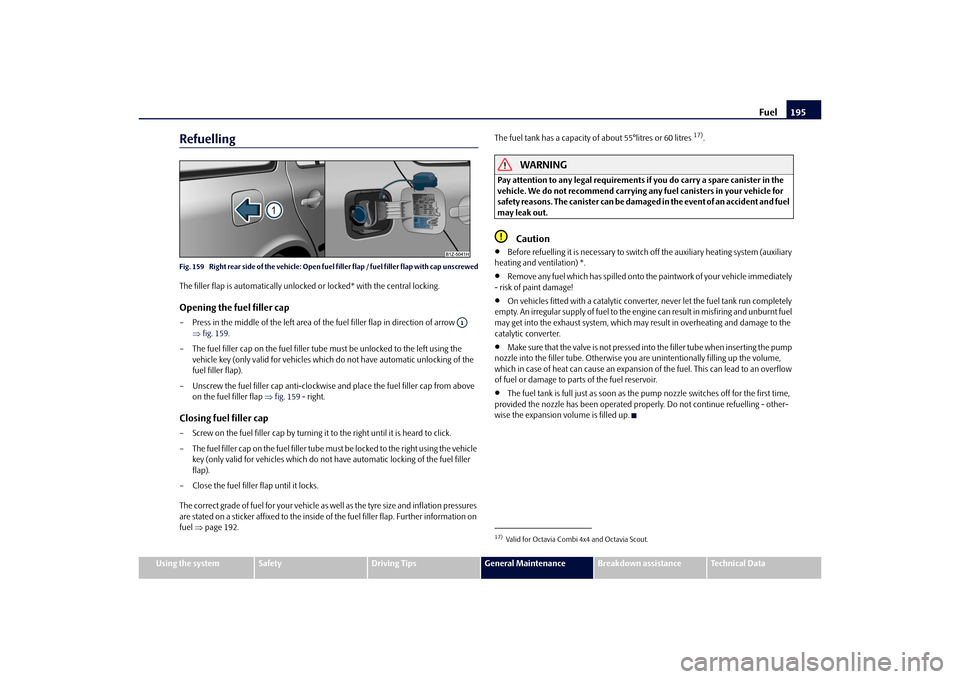
Fuel195
Using the system
Safety
Driving Tips
General Maintenance
Breakdown assistance
Technical Data
RefuellingFig. 159 Right rear side of the vehicle: Open fuel filler flap / fuel filler flap with cap unscrewedThe filler flap is automatically unlocked or locked* with the central locking.Opening the fuel filler cap– Press in the middle of the left area of the fuel filler flap in direction of arrow
fig. 159 .
– The fuel filler cap on the fuel filler tube must be unlocked to the left using the
vehicle key (only valid for vehicles which do not have automatic unlocking of the
fuel filler flap).
– Unscrew the fuel filler cap anti-clockwise and place the fuel filler cap from above
on the fuel filler flap fig. 159 - right.Closing fuel filler cap– Screw on the fuel filler cap by turning it to the right until it is heard to click.
– The fuel filler cap on the fuel filler tube mu st be locked to the right using the vehicle
key (only valid for vehicles which do not ha ve automatic locking of the fuel filler
flap).
– Close the fuel filler flap until it locks.
The correct grade of fuel for your vehicle as well as the tyre size and inflation pressures
are stated on a sticker affixed to the inside of the fuel filler flap. Further information on
fuel page 192. The fuel tank has a capacity of about 55°litres or 60 litres
17).
WARNING
Pay attention to any legal requirements if
you do carry a spare canister in the
vehicle. We do not recommend carrying any fuel canisters in your vehicle for
safety reasons. The canister can be damaged in the event of an accident and fuel
may leak out.
Caution
Before refuelling it is necessary to switch off the auxiliary heating system (auxiliary
heating and ventilation) *.
Remove any fuel which has spilled onto th e paintwork of your vehicle immediately
- risk of paint damage!
On vehicles fitted with a ca talytic converter, never let the fuel tank run completely
empty. An irregular supply of fuel to the engine can result in misfiring and unburnt fuel
may get into the exhaust system, which may result in overheating and damage to the
catalytic converter.
Make sure that the valve is not pressed into the filler tube when inserting the pump
nozzle into the filler tube. Otherwise you ar e unintentionally filling up the volume,
which in case of heat can cause an expansion of the fuel. This can lead to an overflow
of fuel or damage to parts of the fuel reservoir.
The fuel tank is full just as soon as the pump nozzle switches off for the first time,
provided the nozzle has been operated properly. Do not continue refuelling - other-
wise the expansion volume is filled up.
A1
17)Valid for Octavia Combi 4x4 and Octavia Scout.
s43s.1.book Page 195 Thursday, May 13, 2010 1:21 PM
Page 197 of 275
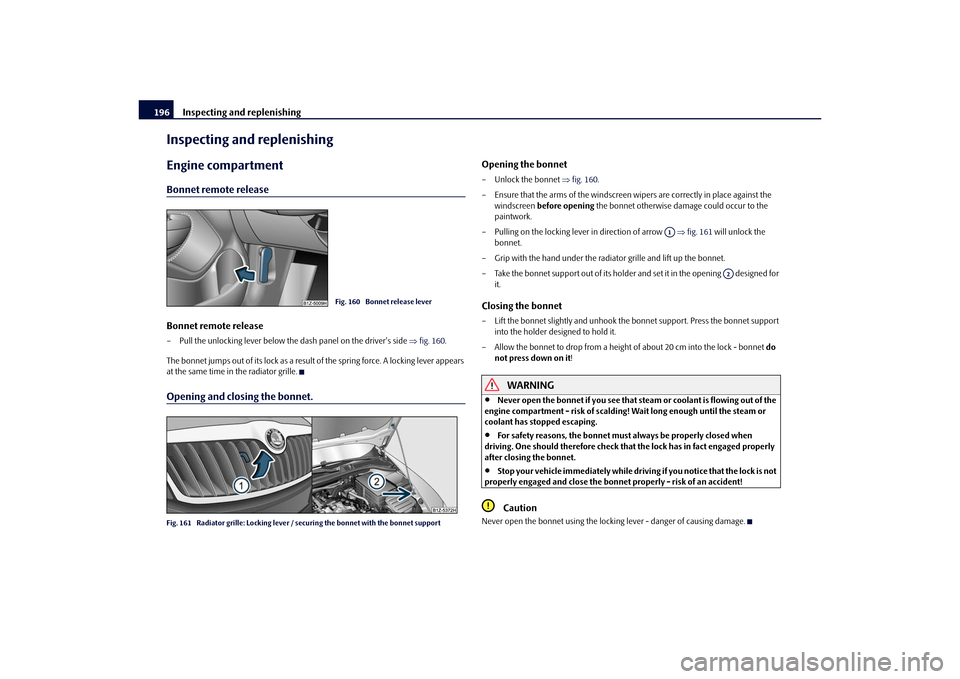
Inspecting and replenishing
196
Inspecting and replenishingEngine compartmentBonnet remote releaseBonnet remote release– Pull the unlocking lever below the dash panel on the driver's side fig. 160 .
The bonnet jumps out of its lock as a result of the spring force. A locking lever appears
at the same time in the radiator grille.Opening and closing the bonnet.Fig. 161 Radiator grille: Locking lever / se curing the bonnet with the bonnet support
Opening the bonnet– Unlock the bonnet fig. 160 .
– Ensure that the arms of the windscreen wipers are correctly in place against the windscreen before opening the bonnet otherwise damage could occur to the
paintwork.
– Pulling on the locking leve r in direction of arrow fig. 161 will unlock the
bonnet.
– Grip with the hand under the radiator grille and lift up the bonnet.
– Take the bonnet support out of its holder and set it in the opening designed for
it.Closing the bonnet– Lift the bonnet slightly and unhook the bonnet support. Press the bonnet support into the holder designed to hold it.
– Allow the bonnet to drop from a height of about 20 cm into the lock - bonnet do
not press down on it !
WARNING
Never open the bonnet if you see that steam or coolant is flowing out of the
engine compartment - risk of scalding! Wait long enough until the steam or
coolant has stopped escaping.
For safety reasons, the bonnet must always be properly closed when
driving. One should therefore check that the lock has in fact engaged properly
after closing the bonnet.
Stop your vehicle immediately while driving if you notice that the lock is not
properly engaged and close the bonnet properly - risk of an accident!Caution
Never open the bonnet using the locking lever - danger of causing damage.
Fig. 160 Bonnet release lever
A1
A2
s43s.1.book Page 196 Thursday, May 13, 2010 1:21 PM
Page 198 of 275
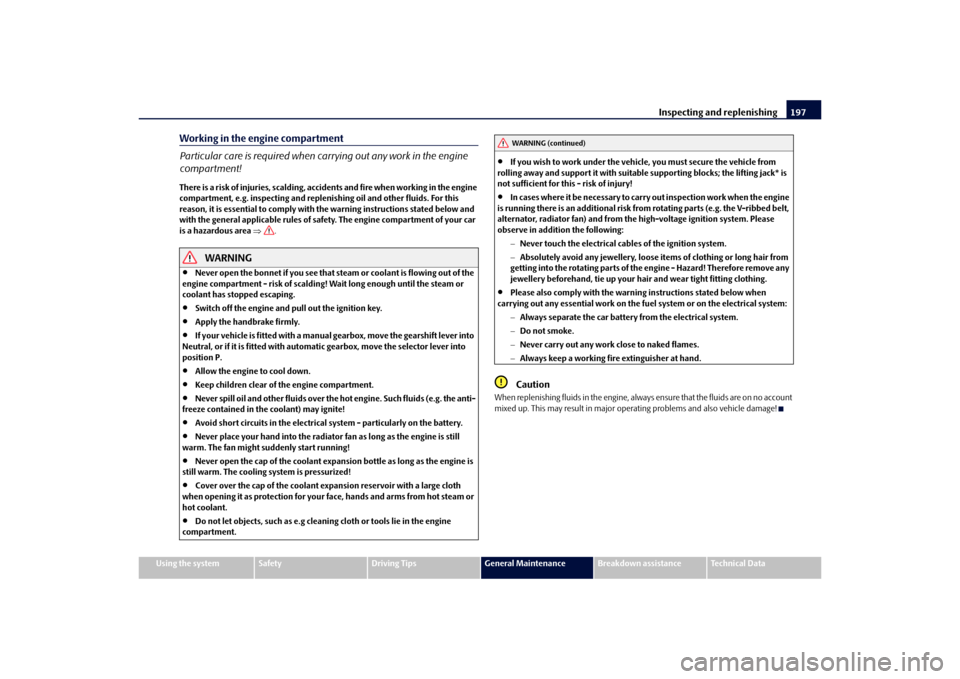
Inspecting and replenishing197
Using the system
Safety
Driving Tips
General Maintenance
Breakdown assistance
Technical Data
Working in the engine compartment
Particular care is required when carrying out any work in the engine
compartment!There is a risk of injuries, scalding, acci dents and fire when working in the engine
compartment, e.g. inspecting and replenishing oil and other fluids. For this
reason, it is essential to comply with the warning instructions stated below and
with the general applicable rules of safe ty. The engine compartment of your car
is a hazardous area .
WARNING
Never open the bonnet if you see that steam or coolant is flowing out of the
engine compartment - risk of scalding! Wait long enough until the steam or
coolant has stopped escaping.
Switch off the engine and pull out the ignition key.
Apply the handbrake firmly.
If your vehicle is fitted with a manual gearbox, move the gearshift lever into
Neutral, or if it is fitted with automatic gearbox, move the selector lever into
position P.
Allow the engine to cool down.
Keep children clear of the engine compartment.
Never spill oil and other fluids over the hot engine. Such fluids (e.g. the anti-
freeze contained in the coolant) may ignite!
Avoid short circuits in the electrical system - particularly on the battery.
Never place your hand into the radiator fan as long as the engine is still
warm. The fan might su ddenly start running!
Never open the cap of the coolant expans ion bottle as long as the engine is
still warm. The cooling system is pressurized!
Cover over the cap of the coolant expansion reservoir with a large cloth
when opening it as protection for your face, hands and arms from hot steam or
hot coolant.
Do not let objects, such as e.g cleaning cloth or tools lie in the engine
compartment.
If you wish to work under the vehicl e, you must secure the vehicle from
rolling away and support it with suitable supporting blocks; the lifting jack* is
not sufficient for this - risk of injury!
In cases where it be necessary to carry out inspection work when the engine
is running there is an additional risk fr om rotating parts (e.g. the V-ribbed belt,
alternator, radiator fan) and from the high-voltage ignition system. Please
observe in addition the following:
Never touch the electrical cabl es of the ignition system.
Absolutely avoid any jewellery, loose it ems of clothing or long hair from
getting into the rotating parts of the engine - Hazard! Therefore remove any
jewellery beforehand, tie up your hair and wear tight fitting clothing.
Please also comply with the warnin g instructions stated below when
carrying out any essential work on the fu el system or on the electrical system:
Always separate the car battery from the electrical system.
Do not smoke.
Never carry out any work close to naked flames.
Always keep a working fire extinguisher at hand.Caution
When replenishing fluids in the engine, always ensure that the fluids are on no account
mixed up. This may result in major oper ating problems and also vehicle damage!
WARNING (continued)
s43s.1.book Page 197 Thursday, May 13, 2010 1:21 PM
Page 199 of 275
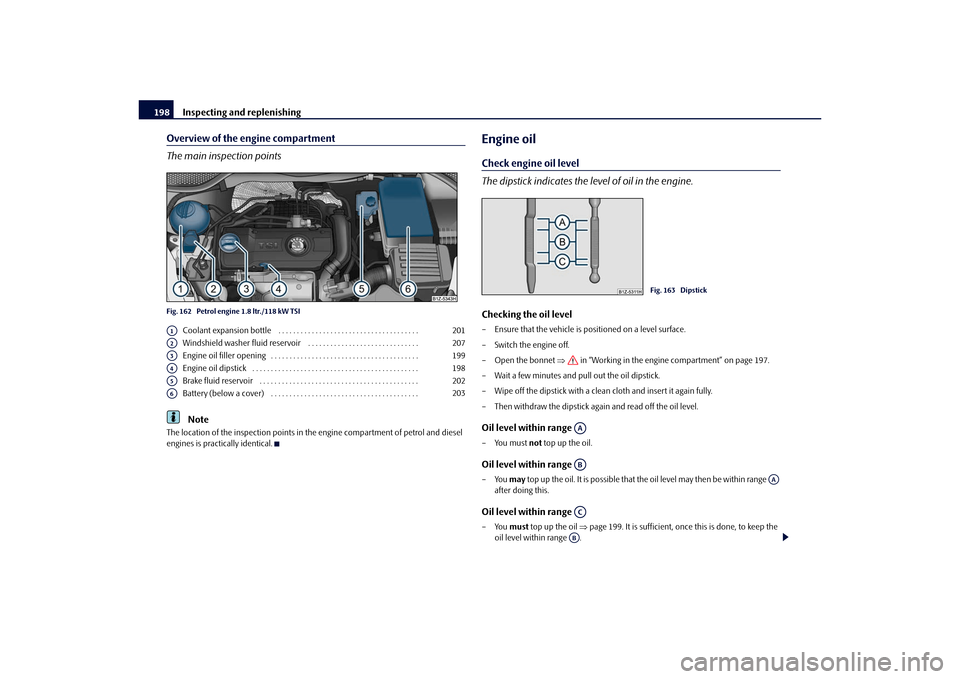
Inspecting and replenishing
198
Overview of the engine compartment
The main inspection pointsFig. 162 Petrol engine 1.8 ltr./118 kW TSI
Coolant expansion bottle . . . . . . . . . . . . . . . . . . . . . . . . . . . . . . . . . . . . . .
Windshield washer fluid reservoir . . . . . . . . . . . . . . . . . . . . . . . . . . . . . .
Engine oil filler opening . . . . . . . . . . . . . . . . . . . . . . . . . . . . . . . . . . . . . . . .
Engine oil dipstick . . . . . . . . . . . . . . . . . . . . . . . . . . . . . . . . . . . . . . . . . . . . .
Brake fluid reservoir . . . . . . . . . . . . . . . . . . . . . . . . . . . . . . . . . . . . . . . . . . .
Battery (below a cover) . . . . . . . . . . . . . . . . . . . . . . . . . . . . . . . . . . . . . . . . Note
The location of the inspection points in th e engine compartment of petrol and diesel
engines is practically identical.
Engine oilCheck engine oil level
The dipstick indicates the le vel of oil in the engine.Checking the oil level– Ensure that the vehicle is po sitioned on a level surface.
– Switch the engine off.
– Open the bonnet in “Working in the engine compartment” on page 197.
– Wait a few minutes and pull out the oil dipstick.
– Wipe off the dipstick with a clea n cloth and insert it again fully.
– Then withdraw the dipstick again and read off the oil level.Oil level within range –You must not top up the oil.Oil level within range –You may top up the oil. It is possible that the oil level may then be within range
after doing this.Oil level within range –You must top up the oil page 199. It is sufficient, once this is done, to keep the
oil level within range .
A1
201
A2
207
A3
199
A4
198
A5
202
A6
203
Fig. 163 Dipstick
AAAB
AA
ACAB
s43s.1.book Page 198 Thursday, May 13, 2010 1:21 PM
Page 200 of 275
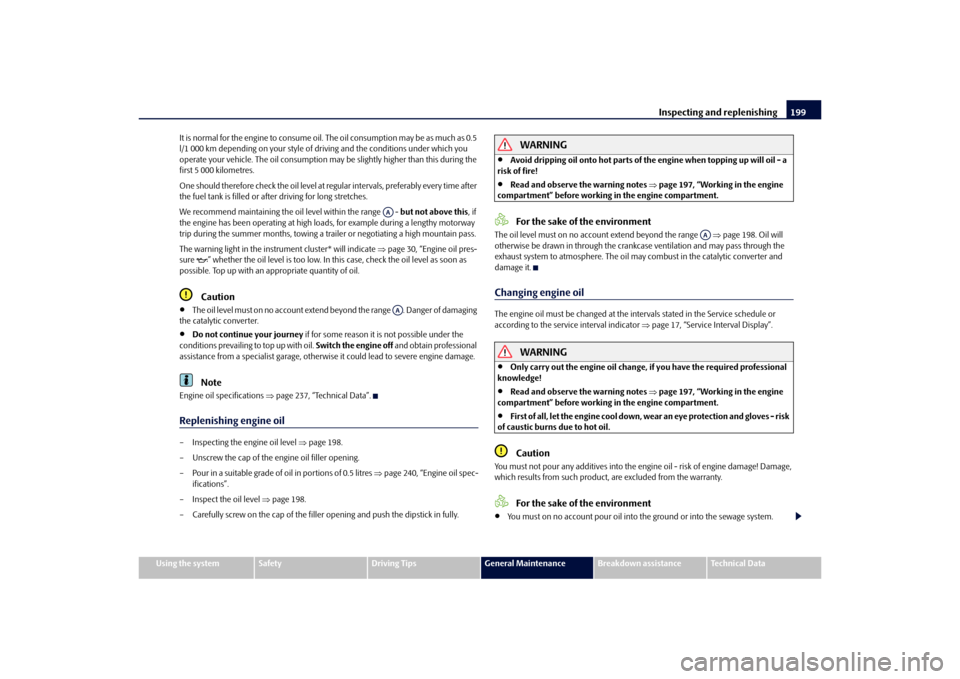
Inspecting and replenishing199
Using the system
Safety
Driving Tips
General Maintenance
Breakdown assistance
Technical Data
It is normal for the engine to consume oil.
The oil consumption may be as much as 0.5
l/1 000 km depending on your style of driving and the conditions under which you
operate your vehicle. The oil consumption may be slightly hi gher than this during the
first 5 000 kilometres.
One should therefore check the oil level at regular intervals, preferably every time after
the fuel tank is filled or after driving for long stretches.
We recommend maintaining the oil level within the range - but not above this, if
the engine has been operating at high load s, for example during a lengthy motorway
trip during the summer months, towing a tr ailer or negotiating a high mountain pass.
The warning light in the instrument cluster* will indicate page 30, “Engine oil pres-
sure ” whether the oil level is too low. In this case, check the oil level as soon as
possible. Top up with an appropriate quantity of oil.
Caution
The oil level must on no ac count extend beyond the range . Danger of damaging
the catalytic converter.
Do not continue your journey if for some reason it is not possible under the
conditions prevailing to top up with oil. Switch the engine off and obtain professional
assistance from a specialist garage, otherwise it could lead to severe engine damage.Note
Engine oil specifications page 237, “Technical Data”.Replenishing engine oil– Inspecting the engine oil level page 198.
– Unscrew the cap of the engine oil filler opening.
– Pour in a suitable grade of oil in portions of 0.5 litres page 240, “Engine oil spec-
ifications”.
– Inspect the oil level page 198.
– Carefully screw on the cap of the filler opening and push the dipstick in fully.
WARNING
Avoid dripping oil onto hot parts of the engine when topping up will oil - a
risk of fire!
Read and observe the warning notes page 197, “Working in the engine
compartment” before working in the engine compartment.For the sake of the environment
The oil level must on no account extend beyond the range page 198. Oil will
otherwise be drawn in through the crankc ase ventilation and may pass through the
exhaust system to atmosphere. The oil ma y combust in the catalytic converter and
damage it.Changing engine oilThe engine oil must be changed at the intervals stated in the Service schedule or
according to the service interval indicator page 17, “Service Interval Display”.
WARNING
Only carry out the engine oil change, if you have the required professional
knowledge!
Read and observe the warning notes page 197, “Working in the engine
compartment” before working in the engine compartment.
First of all, let the engine cool down, we ar an eye protection and gloves - risk
of caustic burns due to hot oil.Caution
You must not pour any additives into the engine oil - risk of engine damage! Damage,
which results from such product, are excluded from the warranty.
For the sake of the environment
You must on no account pour oil into the ground or into the sewage system.
AAAA
AA
s43s.1.book Page 199 Thursday, May 13, 2010 1:21 PM
Page 201 of 275
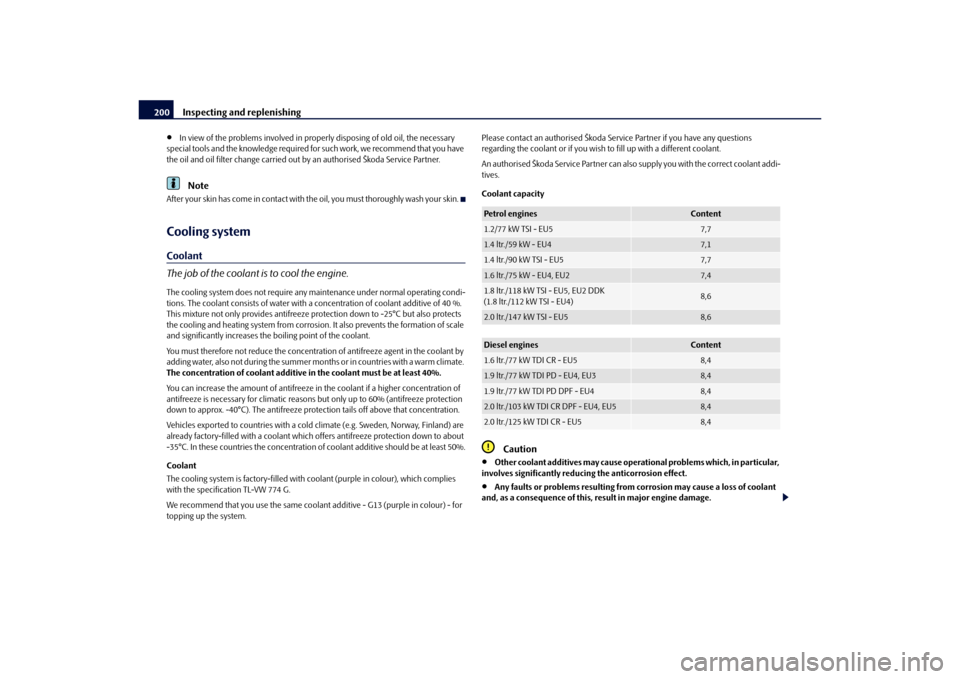
Inspecting and replenishing
200
In view of the problems involved in prop erly disposing of old oil, the necessary
special tools and the knowledge required for such work, we recommend that you have
the oil and oil filter change carried out by an authorised Škoda Service Partner.Note
After your skin has come in contact with th e oil, you must thoroughly wash your skin.Cooling systemCoolant
The job of the coolant is to cool the engine.The cooling system does not require any maintenance under normal operating condi-
tions. The coolant consists of water with a concentration of coolant additive of 40 %.
This mixture not only provides antifreeze protection down to -25°C but also protects
the cooling and heating system from corrosion. It also prevents the formation of scale
and significantly increases the boiling point of the coolant.
You must therefore not reduce the concentration of antifreeze agent in the coolant by
adding water, also not during the summer mo nths or in countries with a warm climate.
The concentration of coolant additive in the coolant must be at least 40%.
You can increase the amount of antifreeze in the coolant if a higher concentration of
antifreeze is necessary for cl imatic reasons but only up to 60% (antifreeze protection
down to approx. -40°C). The antifreeze prot ection tails off above that concentration.
Vehicles exported to countries with a cold climate (e.g. Sweden, Norway, Finland) are
already factory-filled with a coolant which of fers antifreeze protection down to about
-35°C. In these countries the concentration of coolant additive should be at least 50%.
Coolant
The cooling system is factor y-filled with coolant (purple in colour), which complies
with the specification TL-VW 774 G.
We recommend that you use the same coolan t additive - G13 (purple in colour) - for
topping up the system. Please contact an authorised Škoda Serv
ice Partner if you have any questions
regarding the coolant or if you wish to fill up with a different coolant.
An authorised Škoda Service Partner can also supply you with the correct coolant addi-
tives.
Coolant capacity
Caution
Other coolant additives may cause operat ional problems which, in particular,
involves significantly reduci ng the anticorrosion effect.
Any faults or problems resulting from corrosion may cause a loss of coolant
and, as a consequence of this, result in major engine damage.Petrol engines
Content
1.2/77 kW TSI - EU5
7,7
1.4 ltr./59 kW - EU4
7,1
1.4 ltr./90 kW TSI - EU5
7,7
1.6 ltr./75 kW - EU4, EU2
7,4
1.8 ltr./118 kW TSI - EU5, EU2 DDK
(1.8 ltr./112 kW TSI - EU4)
8,6
2.0 ltr./147 kW TSI - EU5
8,6
Diesel engines
Content
1.6 ltr./77 kW TDI CR - EU5
8,4
1.9 ltr./77 kW TDI PD - EU4, EU3
8,4
1.9 ltr./77 kW TDI PD DPF - EU4
8,4
2.0 ltr./103 kW TDI CR DPF - EU4, EU5
8,4
2.0 ltr./125 kW TDI CR - EU5
8,4
s43s.1.book Page 200 Thursday, May 13, 2010 1:21 PM
Page 202 of 275
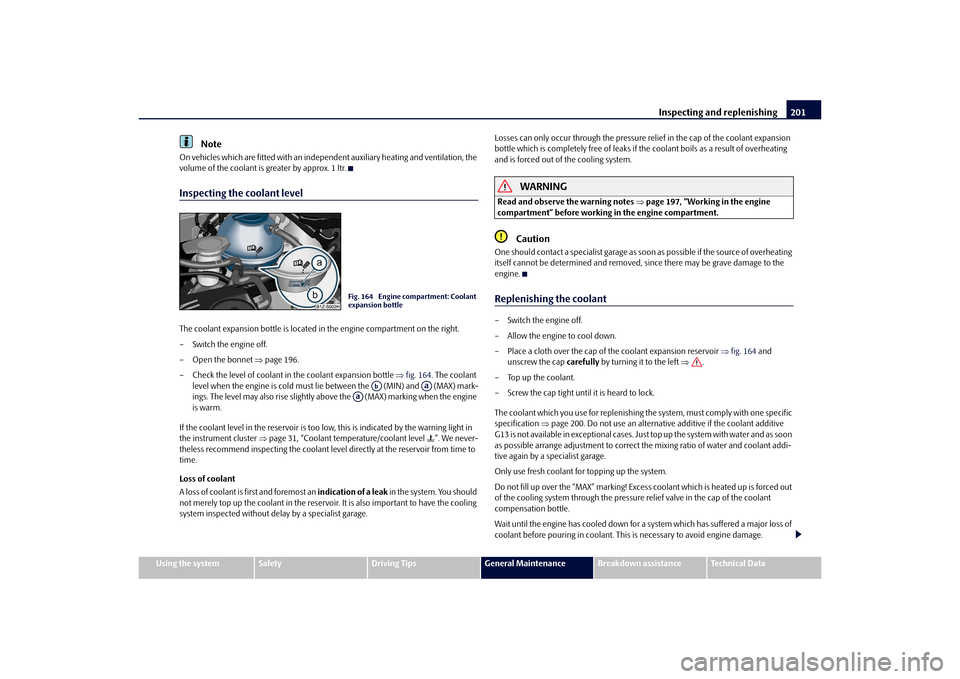
Inspecting and replenishing201
Using the system
Safety
Driving Tips
General Maintenance
Breakdown assistance
Technical Data
Note
On vehicles which are fitted with an indepe ndent auxiliary heating and ventilation, the
volume of the coolant is greater by approx. 1 ltr.Inspecting the coolant levelThe coolant expansion bottle is located in the engine compartment on the right.
– Switch the engine off.
– Open the bonnet page 196.
– Check the level of coolant in the coolant expansion bottle fig. 164 . The coolant
level when the engine is cold must lie between the (MIN) and (MAX) mark-
ings. The level may also rise slightly above the (MAX) marking when the engine
is warm.
If the coolant level in the reservoir is too lo w, this is indicated by the warning light in
the instrument cluster page 31, “Coolant temperature/coolant level ”. We never-
theless recommend inspecting the coolant leve l directly at the reservoir from time to
time.
Loss of coolant
A loss of coolant is first and foremost an indication of a leak in the system. You should
not merely top up the coolant in the reservoir. It is also important to have the cooling
system inspected without delay by a specialist garage. Losses can only occur through the pressure
relief in the cap of the coolant expansion
bottle which is completely free of leaks if the coolant boils as a result of overheating
and is forced out of the cooling system.
WARNING
Read and observe the warning notes page 197, “Working in the engine
compartment” before working in the engine compartment.
Caution
One should contact a specialist garage as s oon as possible if the source of overheating
itself cannot be determined and removed, since there may be grave damage to the
engine.Replenishing the coolant– Switch the engine off.
– Allow the engine to cool down.
– Place a cloth over the cap of the coolant expansion reservoir fig. 164 and
unscrew the cap carefully by turning it to the left .
–Top up the coolant.
– Screw the cap tight until it is heard to lock.
The coolant which you use for replenishing th e system, must comply with one specific
specification page 200. Do not use an alternative additive if the coolant additive
G13 is not available in exceptional cases. Just top up the system with water and as soon
as possible arrange adjustment to correct the mixing ratio of water and coolant addi-
tive again by a specialist garage.
Only use fresh coolant for topping up the system.
Do not fill up over the “MAX” marking! Excess coolant which is heated up is forced out
of the cooling system through the pressure relief valve in the cap of the coolant
compensation bottle.
Wait until the engine has cooled down for a system which has suffered a major loss of
coolant before pouring in coolant. This is necessary to avoid engine damage.
Fig. 164 Engine compartment: Coolant
expansion bottle
Ab
Aa
Aa
s43s.1.book Page 201 Thursday, May 13, 2010 1:21 PM
Page 203 of 275
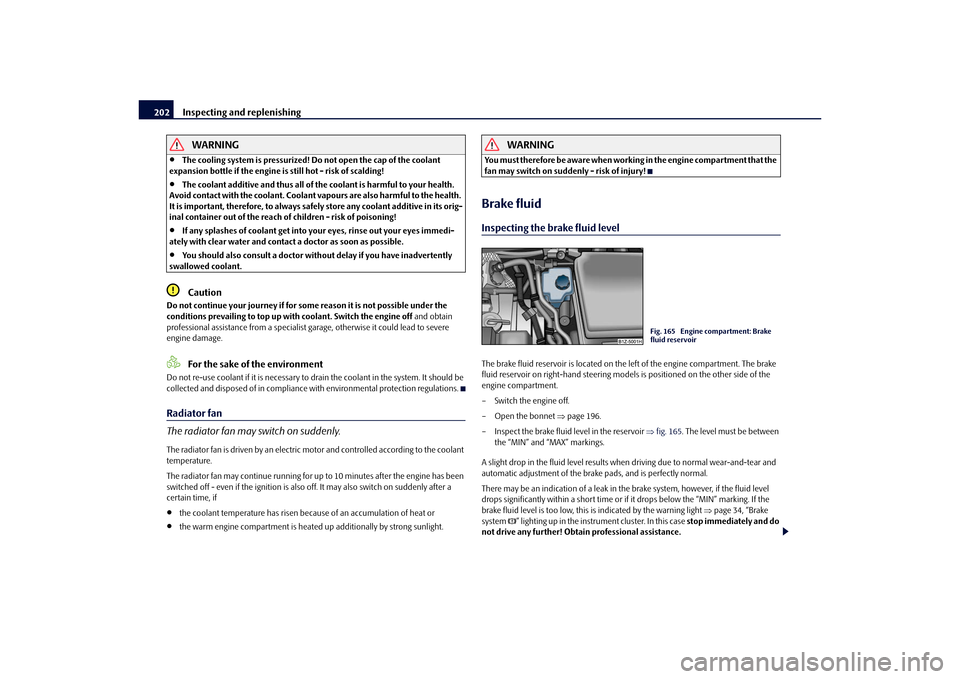
Inspecting and replenishing
202WARNING
The cooling system is pressurized! Do not open the cap of the coolant
expansion bottle if the engine is still hot - risk of scalding!
The coolant additive and thus all of the coolant is harmful to your health.
Avoid contact with the coolant. Coolant vapours are also harmful to the health.
It is important, therefore, to always safely store any coolant additive in its orig-
inal container out of the reach of children - risk of poisoning!
If any splashes of coolant get into yo ur eyes, rinse out your eyes immedi-
ately with clear water and contact a doctor as soon as possible.
You should also consult a doctor without delay if you have inadvertently
swallowed coolant.Caution
Do not continue your journey if for some reason it is not possible under the
conditions prevailing to top up with coolant. Switch the engine off and obtain
professional assistance from a specialist garage, otherwise it could lead to severe
engine damage.
For the sake of the environment
Do not re-use coolant if it is necessary to drain the coolant in the system. It should be
collected and disposed of in compliance with environmental protection regulations.Radiator fan
The radiator fan may switch on suddenly.The radiator fan is driven by an electric motor and controlled according to the coolant
temperature.
The radiator fan may continue running for up to 10 minutes after the engine has been
switched off - even if the ignition is also off. It may also switch on suddenly after a
certain time, if
the coolant temperature has risen beca use of an accumulation of heat or
the warm engine compartment is heated up additionally by strong sunlight.
WARNING
You must therefore be aware when working in the engine compartment that the
fan may switch on suddenly - risk of injury!Brake fluidInspecting the brake fluid levelThe brake fluid reservoir is located on the left of the engine compartment. The brake
fluid reservoir on right-hand steering models is positioned on the other side of the
engine compartment.
– Switch the engine off.
– Open the bonnet page 196.
– Inspect the brake fluid level in the reservoir fig. 165 . The level must be between
the “MIN” and “MAX” markings.
A slight drop in the fluid level results when driving due to normal wear-and-tear and
automatic adjustment of the brak e pads, and is perfectly normal.
There may be an indication of a leak in th e brake system, however, if the fluid level
drops significantly within a short time or if it drops below the “MIN” marking. If the
brake fluid level is too low, this is indicated by the warning light page 34, “Brake
system ” lighting up in the instru ment cluster. In this case stop immediately and do
not drive any further! Obtain professional assistance.
Fig. 165 Engine compartment: Brake
fluid reservoir
s43s.1.book Page 202 Thursday, May 13, 2010 1:21 PM
Page 204 of 275
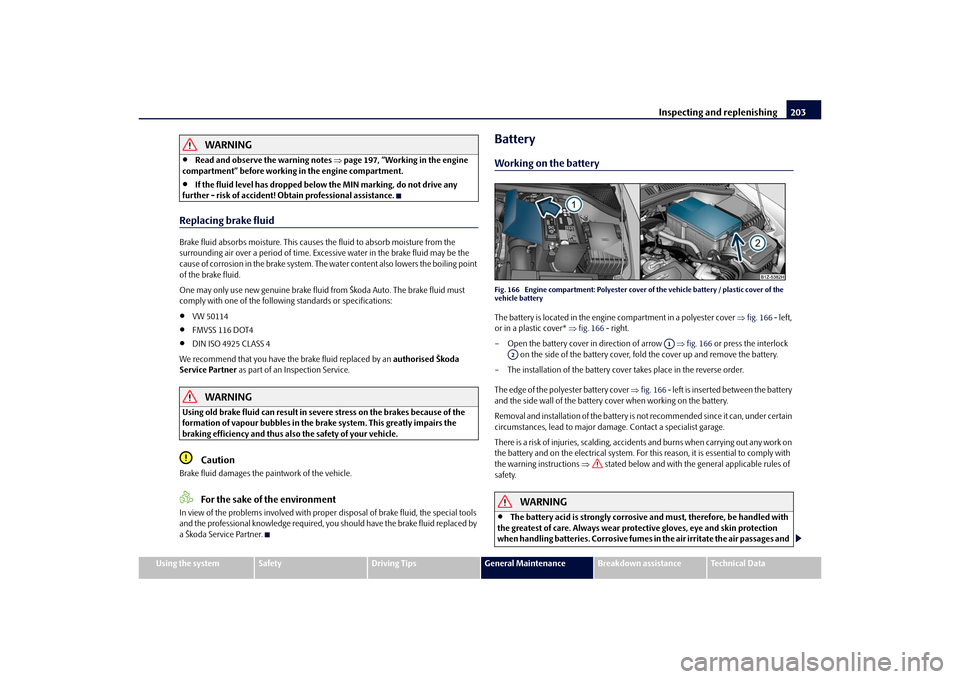
Inspecting and replenishing203
Using the system
Safety
Driving Tips
General Maintenance
Breakdown assistance
Technical Data
WARNING
Read and observe the warning notes page 197, “Working in the engine
compartment” before working in the engine compartment.
If the fluid level has dropped below the MIN marking, do not drive any
further - risk of accident! Obtain professional assistance.
Replacing brake fluidBrake fluid absorbs moisture. This causes the fluid to absorb moisture from the
surrounding air over a period of time. Excessive water in the brake fluid may be the
cause of corrosion in the brake system. The water content also lowers the boiling point
of the brake fluid.
One may only use new genuine brake fluid from Škoda Auto. The brake fluid must
comply with one of the following standards or specifications:
VW 50114
FMVSS 116 DOT4
DIN ISO 4925 CLASS 4
We recommend that you have the brake fluid replaced by an authorised Škoda
Service Partner as part of an Inspection Service.
WARNING
Using old brake fluid can result in severe stress on the brakes because of the
formation of vapour bubbles in the br ake system. This greatly impairs the
braking efficiency and thus also the safety of your vehicle.
Caution
Brake fluid damages the paintwork of the vehicle.
For the sake of the environment
In view of the problems involved with proper disposal of brake fluid, the special tools
and the professional knowledge required, you should have the brake fluid replaced by
a Škoda Service Partner.
BatteryWorking on the batteryFig. 166 Engine compartment: Polyester cover of the vehicle battery / plastic cover of the
vehicle batteryThe battery is located in the engine compartment in a polyester cover fig. 166 - left,
or in a plastic cover* fig. 166 - right.
– Open the battery cover in direction of arrow fig. 166 or press the interlock
on the side of the battery cover, fold the cover up and remove the battery.
– The installation of the battery co ver takes place in the reverse order.
The edge of the polyester battery cover fig. 166 - left is inserted between the battery
and the side wall of the battery co ver when working on the battery.
Removal and installation of the battery is not recommended since it can, under certain
circumstances, lead to major dama ge. Contact a specialist garage.
There is a risk of injuries, scalding, accidents and burns when carrying out any work on
the battery and on the electrical system. For th is reason, it is essential to comply with
the warning instructions stated below and with the general applicable rules of
safety.
WARNING
The battery acid is strongly corrosive and must, therefore, be handled with
the greatest of care. Always wear prot ective gloves, eye and skin protection
when handling batteries. Corrosive fumes in the air irritate the air passages and
A1
A2
s43s.1.book Page 203 Thursday, May 13, 2010 1:21 PM
Page 205 of 275
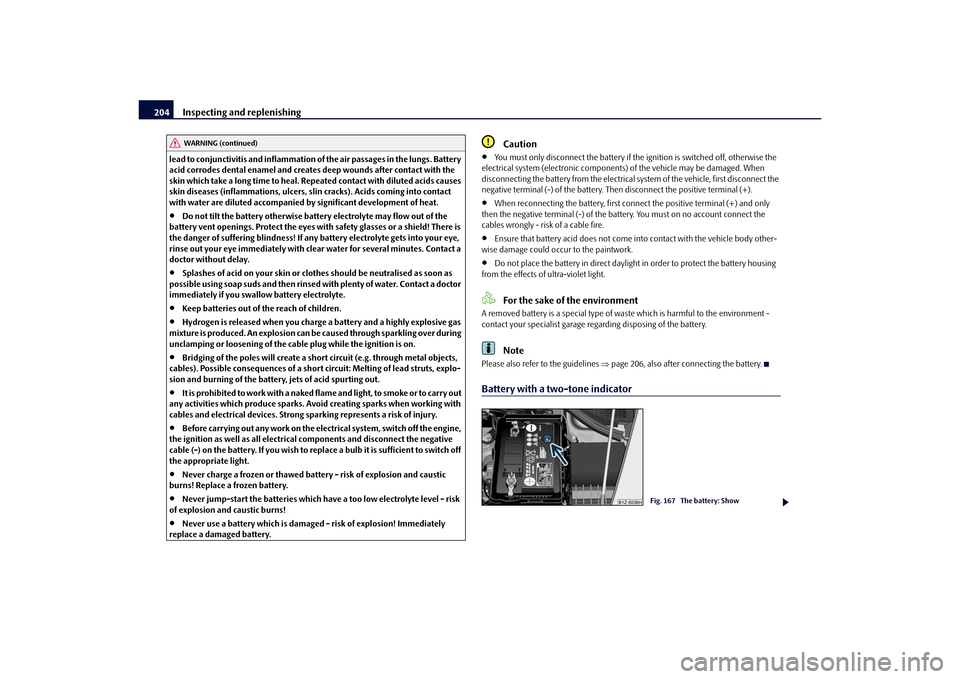
Inspecting and replenishing
204
lead to conjunctivitis and inflammation of the air passages in the lungs. Battery
acid corrodes dental enam el and creates deep wounds after contact with the
skin which take a long time to heal. Repeated contact with diluted acids causes
skin diseases (inflammations, ulcers, slin cracks). Acids coming into contact
with water are diluted accompanied by significant development of heat.
Do not tilt the battery otherwise battery electrolyte may flow out of the
battery vent openings. Protect the eyes with safety glas ses or a shield! There is
the danger of suffering blindness! If an y battery electrolyte gets into your eye,
rinse out your eye immediately with cl ear water for several minutes. Contact a
doctor without delay.
Splashes of acid on your skin or clothes should be neutralised as soon as
possible using soap suds and then rinsed with plenty of water. Contact a doctor
immediately if you swal low battery electrolyte.
Keep batteries out of the reach of children.
Hydrogen is released when you charge a battery and a highly explosive gas
mixture is produced. An explosion can be caused through sparkling over during
unclamping or loosening of the cable plug while the ignition is on.
Bridging of the poles will create a short circuit (e.g. through metal objects,
cables). Possible consequences of a short circuit: Melting of lead struts, explo-
sion and burning of the battery, jets of acid spurting out.
It is prohibited to work with a naked flame and light, to smoke or to carry out
any activities which produce sparks. Avoid creating sparks when working with
cables and electrical devices. Strong sparking represents a risk of injury.
Before carrying out any work on the el ectrical system, switch off the engine,
the ignition as well as all electrical components and disconnect the negative
cable (-) on the battery. If you wish to replace a bulb it is sufficient to switch off
the appropriate light.
Never charge a frozen or thawed batt ery - risk of explosion and caustic
burns! Replace a frozen battery.
Never jump-start the batteries which have a too low electrolyte level - risk
of explosion and caustic burns!
Never use a battery which is damaged - risk of explosion! Immediately
replace a damaged battery.
Caution
You must only disconnect the battery if th e ignition is switched off, otherwise the
electrical system (electronic components ) of the vehicle may be damaged. When
disconnecting the battery from the electrical system of the vehicle, first disconnect the
negative terminal (-) of the battery. Then disconnect the positive terminal (+).
When reconnecting the battery, first connect the positive terminal (+) and only
then the negative terminal (-) of the ba ttery. You must on no account connect the
cables wrongly - risk of a cable fire.
Ensure that battery acid does not come into contact with the vehicle body other-
wise damage could occur to the paintwork.
Do not place the battery in direct daylight in order to protect the battery housing
from the effects of ultra-violet light.For the sake of the environment
A removed battery is a special type of wa ste which is harmful to the environment -
contact your specialist garage regarding disposing of the battery.
Note
Please also refer to the guidelines page 206, also after connecting the battery.Battery with a two-tone indicator
WARNING (continued)
Fig. 167 The battery: Show
s43s.1.book Page 204 Thursday, May 13, 2010 1:21 PM